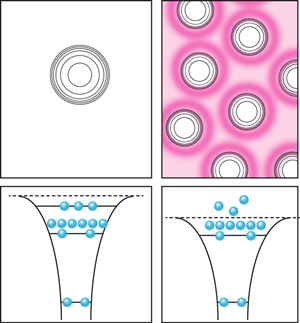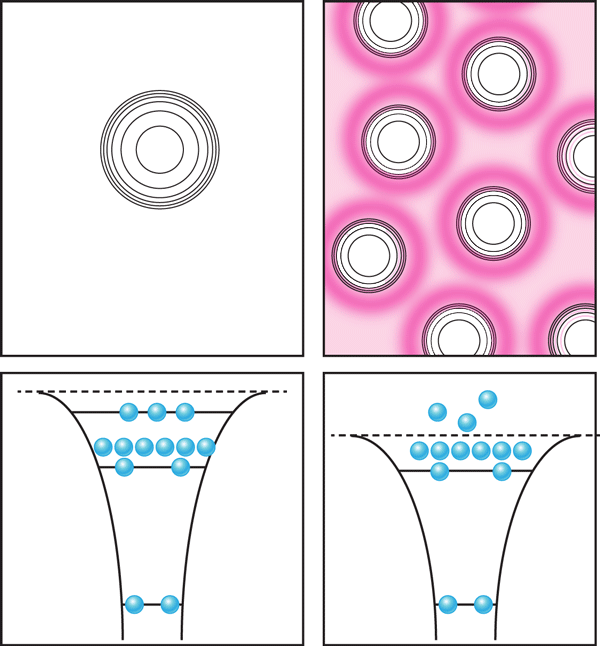Extreme X Rays Probe Extreme Matter
It takes a strong electric field to ionize atoms or ions in the creation of plasmas. These fields can be generated in lightning bolts (electric discharges), neon light bulbs, at the focus of a laser, and in the path of particle beams. It is perhaps less obvious that plasma itself can also have sufficiently strong fields within it to further ionize ions, since one might expect equal amounts of positive and negative charge would cancel each other out. In Physical Review Letters, Orlando Ciricosta at the University of Oxford, UK, and colleagues make use of the world’s brightest x-ray laser source, the Linac Coherent Light Source (LCLS) at the Stanford Linear Accelerator [1], to create a plasma dense enough to test models of how ionization occurs in matter approaching that found in astrophysical bodies or created in thermonuclear fusion [2].
Plasmas are, by definition, in an ionized state and therefore sources of electric fields, but they are also quasineutral because the mobile (free) electrons normally form a cloud around the positive ions, screening their charge. So why would an ion embedded in this environment be further ionized by its surroundings? The answer is that at high plasma densities, the effectiveness of charge screening diminishes, and the ions are positioned more closely together, which increases their interaction potential. Thus electrons bound to a given ion will be attracted outward towards neighboring ions, tending to cancel the usual inward Coulomb attraction that binds the electron to the nucleus. The net result is that the energy required to liberate a bound electron (the ionization potential) gets smaller (Fig. 1). For a weakly bound outer electron, this “ionization-potential depression” can equal the ionization potential itself and the electron becomes free. This latter process is commonly referred to as “pressure ionization,” because pressure is energy density, or “continuum lowering,” because with increasing density, the distinction between the last bound state and the continuum disappears for states of lower quantum number.
Strictly speaking, classical plasmas are quasineutral while the states of matter at high density and low temperature have a high ion interaction potential, and thus behave more like liquids or solids. (In fact, continuum electrons liberated by pressure ionization are responsible for the high conductivity of room-temperature metals.) For ionized media, this state is generally called “warm dense matter.” It occurs within the interiors of certain astrophysical objects, such as the giant gas planets and collapsed stars, as well as within the laser-heated target of an inertially confined, controlled thermonuclear fusion experiment.
Creating warm dense matter in the lab allows us to test theories that predict the dependence of the ionization potential on density and temperature. These theories, in turn, form the basis for simulating what happens in astrophysical conditions. The most controlled way of creating a high-density plasma in the laboratory is to rapidly heat a solid-density object, such as a thin metal foil. If the foil is heated fast enough, then it will not expand much prior to, or during, a measurement of its ionization potential, and the density will remain relatively constant, close to the value of a room-temperature solid. Spectra of the ions as they undergo various atomic transitions show how the ions are affected by the dense plasma environment. These spectra are then compared to the predictions of computer simulations that can include any of a variety of ionization models, and the best match between experiment and theory is found.
Ultrashort-duration laser pulses are an obvious choice for the task of rapidly heating a solid to turn it into a dense plasma. Until recently, the only suitable lasers available were near-infrared (or optical) wavelength lasers, which several experimental groups used [3–5] to measure the degree of continuum lowering, as a function of plasma density. These results, and others, were generally found to agree best with a particular ionization model, the Stewart-Pyatt model [6], which has been incorporated into many simulation-based models in plasma physics.
Ciricosta et al.’s [2] experiments make use of a different type of laser: an x-ray free-electron laser (XFEL). X-ray lasers heat solids differently than infrared lasers do. X rays are a kilo-electron-volt or more and can directly knock out the core electrons from atoms, while infrared light primarily excites only valence and plasma electrons. Also, x rays penetrate much further into a material than infrared radiation. Ciricosta et al. are therefore able to very uniformly radiate the entire solid they studied—an aluminum foil—and heat it to a temperature of ∼100 electron volts (greater than 1 million degrees kelvin), creating solid-density plasma [7].
The x rays also allow the team to probe the K-alpha fluorescence lines in aluminum—the light emitted when an x ray kicks out a core ( K-shell) electron and a valence electron falls into the hole left behind. The ionization potential depression that occurs in the dense plasma shows up as a frequency shift in these fluorescence spectra.
What is surprising about Ciricosta et al.’s results is that their data fit better with a model by Ecker and Kröll [8], which had been proposed earlier than the popular Stewart-Pyatt model but until now was relatively neglected. While both models are simple and semiclassical, the Ecker and Kröll model makes a different assumption in the screening calculation and predicts a larger ionization potential depression. The complexity of ionization in a plasma is such that, as the authors say, neither model can be expected to fully capture it. Nonetheless, this recent study did manage to unambiguously identify which model best fits the data under their particular conditions, which are approaching those of warm dense matter. Their results may prompt reconsideration of the ionization model used in several important astrophysics and fusion simulation codes. Their success can be attributed to both the use of a different experimental methodology, as well as to the better parameter control afforded by the use of an XFEL.
The XFEL work represents, in some sense, a cultural shift. In the past, these measurements were performed in a long-duration campaign by just a few individuals, while Ciricosta et al.’s experiment took more of a blitzkrieg approach: a team of 32 researchers from 10 institutions performed the experiment in a single week. A large collaboration is apparently required to plan and successfully execute an experiment within the short time span allotted to each group at the one-of-a-kind LCLS x-ray laser.
The time pressures on XFEL users may be alleviated in the future. More experimental end-stations are being added at the LCLS, and an even more energetic XFEL is soon to be completed at the Deutsches Elektronen-Synchrotron (DESY) in Hamburg, Germany. Meanwhile, other physicists are employing an entirely different strategy towards increasing the availability of XFELs: they are attempting to shrink their size to a university scale, by replacing the kilometer-long conventional LINAC electron accelerator that runs them with a 10-m-long laser-driven one [9,10]. Coincidentally, these laser drivers are once again the near-infrared lasers used in the earlier studies to heat dense matter. If this effort ultimately succeeds, it will thus bring dense-matter research with infrared lasers full circle. For now though, the study by Ciricosta et al. proves that a large team working with a state-of-the-art laser, even when it’s available only for a limited experimental run, can make an important advance in our understanding of an extreme state of matter.
References
- LCLS homepage, http://lcls.slac.stanford.edu.library.unl.edu
- O. Ciricosta et al., ”Direct Measurements of the Ionization Potential Depression in a Dense Plasma,” Phys. Rev. Lett. 109, 065002 (2012)
- D. K. Bradley, “Time-Resolved Continuum-Edge-Shift Measurements in Laser-Shocked Solids,” Phys. Rev. Lett. 59, 2995 (1987)
- D. Riley, O. Willi, S. J. Rose, and T. Afsharrad, “Blue Shift of the K Absorption Edge in Laser-Shocked Solids,” Europhys. Lett. 10, 135 (1989)
- M. Nantel, G. Ma, S. Gu, C. Y. Cote, J. Itatani, and D. Umstadter, “Pressure Ionization and Line Merging in Strongly Coupled Plasmas Produced by 100-fs Laser Pulses,” Phys. Rev. Lett. 80, 4442 (1998)
- J. C. Stewart and K. D. Pyatt, “Lowering of Ionization Potentials in Plasmas,” Astrophys. J. 144, 1203 (1966)
- S. M. Vinko et al., “Creation and Diagnosis of a Solid-Density Plasma with an X-Ray Free-Electron Laser,” Nature 482, 59 (2012)
- G. Ecker and W. Kröll, “Lowering of the Ionization Energy for a Plasma in Thermodynamic Equilibrium,” Phys. Fluids 6, 62 (1963)
- D. Umstadter, F. He, and Y. Lau, U.S. Patent No. 7,321,604 (2008)
- M. Fuchs et al., “Laser-Driven Soft-X-Ray Undulator Source,” Nature Phys. 5, 826 (2009)





